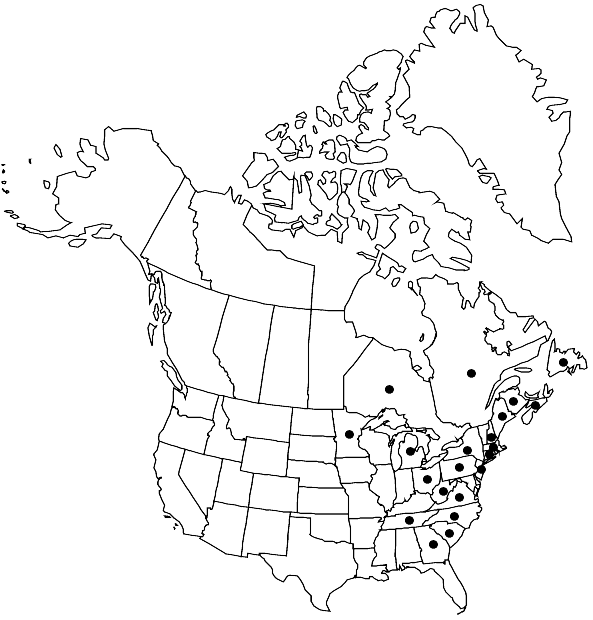Bucklandiella venusta
in R. Ochyra et al., Cens. Cat. Polish Mosses, 147. 2003,.
Plants small to medium-sized, in loose or usually dense mats or tufts, green, yellowish or brownish green to olivaceous in the upper part, darker brown to blackish brown or blackish proximally. Stems (1–)1.5–4.5(–6) cm, prostrate to erect-ascending, usually much subpinnately branched to sparsely branched. Leaves loosely imbricate when dry, erect-spreading to recurved when moist, straight to secund, ovate-lanceolate to lanceolate, keeled distally, narrowly canaliculate proximally, (1.5–)1.7–2.4(–2.6) × 0.5–0.7 mm; margins narrowly recurved to revolute on both sides to near the apex, distinctly wavy to lumpy, 2-stratose for 1–3(–4) cells rows in the distal half, sometimes largely 1-stratose or with 3-stratose patches, largely 1-stratose in the proximal half with 2-stratose spots for 1(–2) cell rows or rarely predominantly 2-stratose; apices acuminate, often muticous or terminated with a short, to 0.5 mm, stout, hyaline, sharply serrate awn, not or hardly decurrent; costa percurrent or excurrent into the awn, strongly convex on the abaxial side, 50–80 µm wide basally, 35–45 µm wide distally, 3(–4)-stratose near the base, with 3–5 adaxial cells, 2–3-stratose in the middle and 2-stratose near the apex with 2–3 adaxial cells; laminal cells 1-stratose smooth or pseudopapillose; basal laminal cells short- to long-rectangular, 15–45 × 7–8 µm moderately thick-walled, sinuose-nodulose; alar cells slightly differentiated, yellowish; supra-alar cells (2–8) often not weakly sinuose, somewhat thick-walled, not forming a basal marginal border; medial and distal laminal cells irregularly isodiametric to rectangular, 5–20 × 7–9 µm. Inner perichaetial leaves strongly differentiated, ovate, narrowly obtuse to subacute at the apex, hyaline throughout. Seta dark red to reddish brown, (3–)6–8 mm. Capsule brown, ovoid, obloid to short-cylindric, (1.2–)1.5–2 × 0.4–0.6 mm, smooth; operculum long-beaked, to 1 mm; peristome teeth 180–200 µm, yellowish brown, papillose, deeply divided into 2–3 irregular prongs arising from a basal membrane, 35–50 µm high. Spores 10–18 µm.
Habitat: Acidic rocks, boulders, cliff faces and bluffs in dry and exposed to shaded and wet sites, in seepage areas, mesic woodlands and on rocks along streams and creeks and on lake shores
Elevation: low to high elevations (0-2000 m)
Distribution

N.B., Nfld. and Labr. (Nfld.), N.S., Ont., Que., Conn., Ga., Maine, Mass., Mich., Minn., N.H., N.J., N.Y., N.C., Ohio, Pa., S.C., Tenn., Va., W.Va.
Discussion
Bucklandiella venusta is largely restricted to the Appalachian Mountains, but ranges from Newfoundland to South Carolina and the Great Lakes Basin, westwards to Lake Superior. It has commonly been confused with B. affinis, B. heterosticha, B. sudetica, and B. microcarpa, and only recently has it been recognized as a distinct species. It is best distinguished by a combination of both gametophyte and sporophyte characters, including ovate and entirely hyaline innermost perichaetial bracts, variously bistratose leaf margins in 1–3(–4) cells rows that are recurved nearly to the apex, muticous or piliferous leaf apices, slightly differentiated alar cells, and an undifferentiated basal marginal border. Bucklandiella venusta is most likely to be mistaken for B. affinis, with which it shares the same form of the innermost perichaetial leaves, but the latter has predominantly 1-stratose leaf margins with only occasional 1-seriate 2-stratose spots that are not wavy or lumpy. Also, the costa in B. affinis is stronger, mostly 4-stratose basally with 5–7 enlarged adaxial cells, and the awn is usually longer, more slender, often narrow and capillaceous distally and flattened basally. Bucklandia heterosticha is unknown in the range of B. venusta but it has much broader and flatter, broadly canaliculate costa, a long hyaline awn, and predominantly 1-stratose leaf margins. Superficially, B. venusta is similar to B. sudetica, however they are only distantly related. They differ fundamentally in the form of the innermost perichaetial leaves, the latter having them only a bit different from the vegetative leaves. In addition, the plants of B. sudetica are less branched and have more weakly recurved leaf margins, to 1/2–3/4 the leaf length usually only on one side, and more or less smooth and even at the sides in the distal half. The latter feature would seem difficult to evaluate, but the leaf margins are so wavy to lumpy on the sides that with experience, this feature can effectively be used to separate the two species. Bucklandiella venusta should not be mistaken for B. microcarpa, the long basal marginal border of 8–15 pellucid, straight-walled cells in the latter being immediately diagnostic. Moreover, the leaf margins in B. microcarpa are 1-stratose, with only occasional 2-stratose spots in the distal portion and the costa has 3–4 much larger adaxial cells as visible in transverse-section.
Selected References
None.